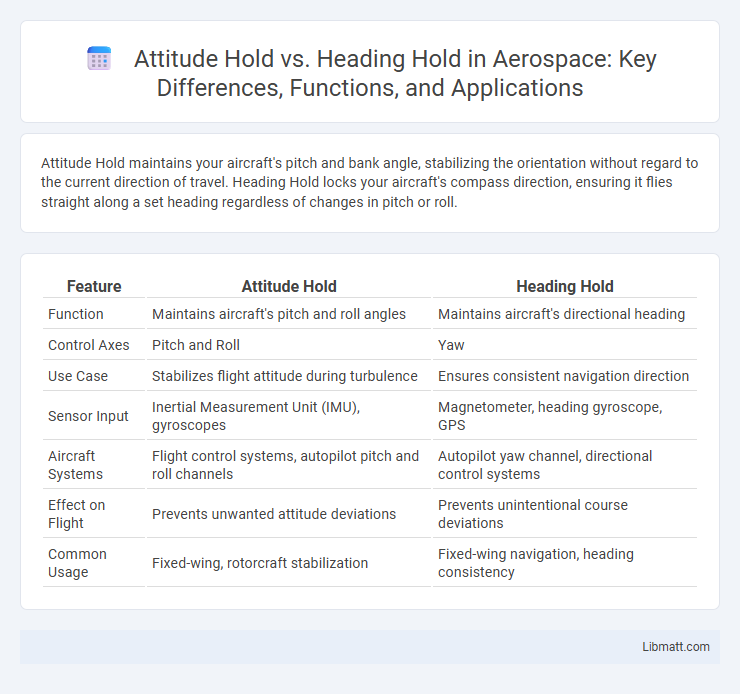Attitude Hold maintains your aircraft's pitch and bank angle, stabilizing the orientation without regard to the current direction of travel. Heading Hold locks your aircraft's compass direction, ensuring it flies straight along a set heading regardless of changes in pitch or roll.
Table of Comparison
| Feature | Attitude Hold | Heading Hold |
|---|---|---|
| Function | Maintains aircraft's pitch and roll angles | Maintains aircraft's directional heading |
| Control Axes | Pitch and Roll | Yaw |
| Use Case | Stabilizes flight attitude during turbulence | Ensures consistent navigation direction |
| Sensor Input | Inertial Measurement Unit (IMU), gyroscopes | Magnetometer, heading gyroscope, GPS |
| Aircraft Systems | Flight control systems, autopilot pitch and roll channels | Autopilot yaw channel, directional control systems |
| Effect on Flight | Prevents unwanted attitude deviations | Prevents unintentional course deviations |
| Common Usage | Fixed-wing, rotorcraft stabilization | Fixed-wing navigation, heading consistency |
Understanding Attitude Hold and Heading Hold
Attitude Hold maintains your aircraft's pitch and roll angles, stabilizing its orientation relative to the horizon to ensure consistent flight behavior. Heading Hold controls the aircraft's directional heading, keeping it on a specific compass bearing without drifting. Understanding these functions helps you effectively manage flight stability and navigation during autopilot operation.
Key Differences Between Attitude and Heading Hold
Attitude Hold maintains your aircraft's pitch and roll angles, stabilizing the orientation relative to the horizon, while Heading Hold controls your aircraft's directional course by maintaining a specific compass heading. Your drone uses Attitude Hold primarily for smooth and level flight, whereas Heading Hold ensures it flies steadily along a set path without drifting sideways. Understanding these key differences enhances your control and precision during flight operations.
How Attitude Hold Works in Flight Systems
Attitude Hold in flight systems works by using gyroscopic sensors and accelerometers to maintain an aircraft's pitch and roll angles automatically, ensuring stable flight without constant pilot input. The flight control system continuously compares real-time attitude data to a preset reference, making precise control surface adjustments to keep the aircraft level or at the chosen orientation. This automation enhances pilot workload reduction and improves flight stability during manual or autopilot operations.
The Mechanism Behind Heading Hold
Heading Hold stabilizes the aircraft's directional orientation by utilizing a magnetic or gyro compass sensor that detects the current heading and automatically corrects deviations to maintain a set course. Unlike Attitude Hold, which focuses on maintaining the aircraft's pitch and roll, Heading Hold actively monitors yaw movements and inputs control commands to the rudder or differential thrust to lock the heading. Your drone or aircraft benefits from precise navigation and improved control during flight by leveraging the sophisticated heading correction mechanism embedded in Heading Hold mode.
Advantages of Using Attitude Hold
Attitude Hold offers precise control by maintaining the aircraft's pitch and roll angles, enhancing stability during turbulent conditions and reducing pilot workload. This mode prevents abrupt orientation changes, improving safety and comfort for passengers. Its intuitive operation allows smoother maneuvering, making it ideal for situations requiring consistent aircraft attitude rather than strict heading maintenance.
Benefits of Heading Hold in Navigation
Heading Hold mode ensures precise directional control by maintaining a fixed compass heading, enhancing navigation accuracy during flight. This functionality reduces pilot workload by preventing unintentional yaw drift, crucial for tasks requiring consistent heading such as aerial surveying or waypoint following. The stability provided by Heading Hold improves safety in adverse weather, enabling smoother and more reliable course correction.
Applications in General and Commercial Aviation
Attitude Hold maintains a fixed aircraft pitch and bank angle, crucial for stable flight during turbulence and initial climb phases in both general and commercial aviation. Heading Hold locks the aircraft's directional heading, essential for precise navigation and maintaining flight paths on instrument routes or during autopilot usage in commercial airliners and private planes alike. Your choice between these modes depends on operational needs, with Attitude Hold offering flight stability and Heading Hold ensuring accurate course guidance.
Limitations of Attitude Hold vs Heading Hold
Attitude Hold maintains aircraft pitch and roll angles but does not regulate direction, which means it cannot control or correct deviations in the aircraft's heading. Heading Hold continuously manages the airplane's yaw, keeping its compass direction stable, but it is limited in handling pitch or roll changes independently. Your flight control system requires both modes to ensure precise orientation and navigation, as relying solely on Attitude Hold can lead to unintended directional drift.
Choosing the Right Mode: Flight Scenarios
Attitude Hold maintains a fixed aircraft orientation relative to the horizon, ideal for steady flight during turbulence or visual flying conditions. Heading Hold locks the aircraft's compass heading, perfect for navigation-focused scenarios like cross-country flights or instrument procedures. Selecting the right mode depends on your flight goals, ensuring smoother control and enhanced situational awareness.
Future Developments in Aircraft Stability Systems
Advancements in aircraft stability systems are increasingly integrating Attitude Hold and Heading Hold functionalities with adaptive algorithms and AI-driven controls, enhancing precision and responsiveness. Future developments will enable your aircraft to automatically correct for environmental disturbances, improving safety and reducing pilot workload. These innovations promise more seamless transitions between manual and automated flight modes, optimizing overall flight performance.
Attitude Hold vs Heading Hold Infographic

 libmatt.com
libmatt.com